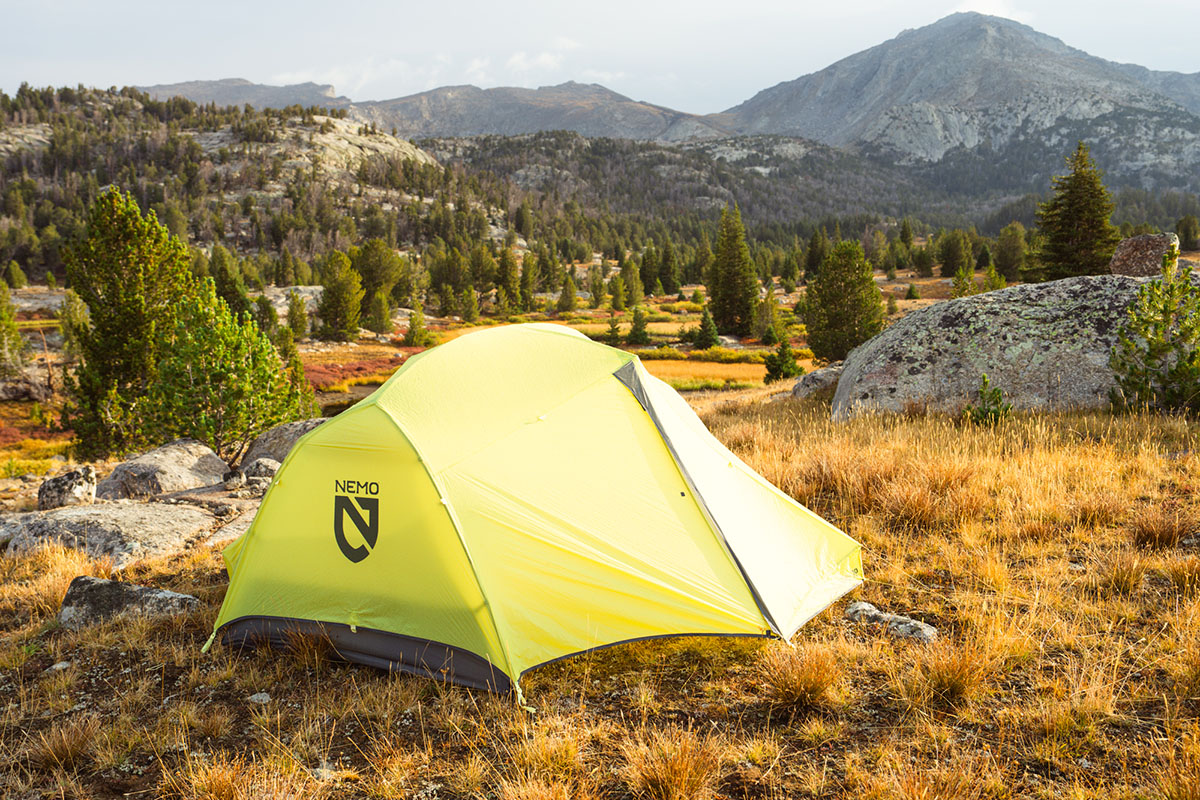

Price: $500
Packaged weight: 3 lb. 15 oz.
Floor area: 30.6 sq. ft.
Capacities: 2P, 3P
What we like: Impressive livability, large vestibules, and a cinch to set up; lighter and cheaper than the prior version.
What we don’t: Still not a class leader in weight or ventilation.
See the Nemo Dagger Osmo 2P at REI See the Nemo Dagger Osmo 2P at Nemo
Nemo’s Dagger has long been considered one of the most livable lightweight backpacking tents on the market, and Nemo recently updated the design with a revamped pole structure that really maximizes the interior. With more headroom, larger vestibules, and a taller door, the latest Dagger has a very open and spacious feel. Not to mention, Nemo managed to trim a respectable 3 ounces and $30 off the prior version. All in all, the Dagger remains one of the most comfortable and well-equipped options for two backpackers. Below we outline our experiences with the Dagger Osmo 2P. To see how it stacks up to the competition, check out our article on the best backpacking tents.
Editor’s note: We updated this review on March 27, 2025, to reflect our experiences with the latest Dagger 2P, which was released in early 2025. Key changes include a reduced price, a slightly lower weight, retooled corner anchors, and a revamped pole structure that results in more headroom and vestibule space.
The past version of the Dagger Osmo 2P wasn’t a standout in the weight department at 4 pounds 2 ounces all in, but Nemo trimmed away a respectable 3 ounces during their latest update. This puts it closer to many direct competitors, although there’s still room for improvement: Among top backpacking models, MSR’s Hubba Hubba LT checks in 9 ounces lighter at 3 pounds 6 ounces all in, while the more expensive and less durable Big Agnes Copper Spur UL2 shaves off a little more at 3 pounds even. You can save even more weight with the Big Agnes Tiger Wall UL2 or Nemo’s own Hornet Osmo 2P (both 2 lb. 8 oz.), but the Dagger is much roomier for two backpackers, and we think those models are best for solo trips. All in all, the Dagger Osmo clearly isn’t a featherweight, but it’s not a burden to carry and offers more livable space than most of the options mentioned above (more on this below).
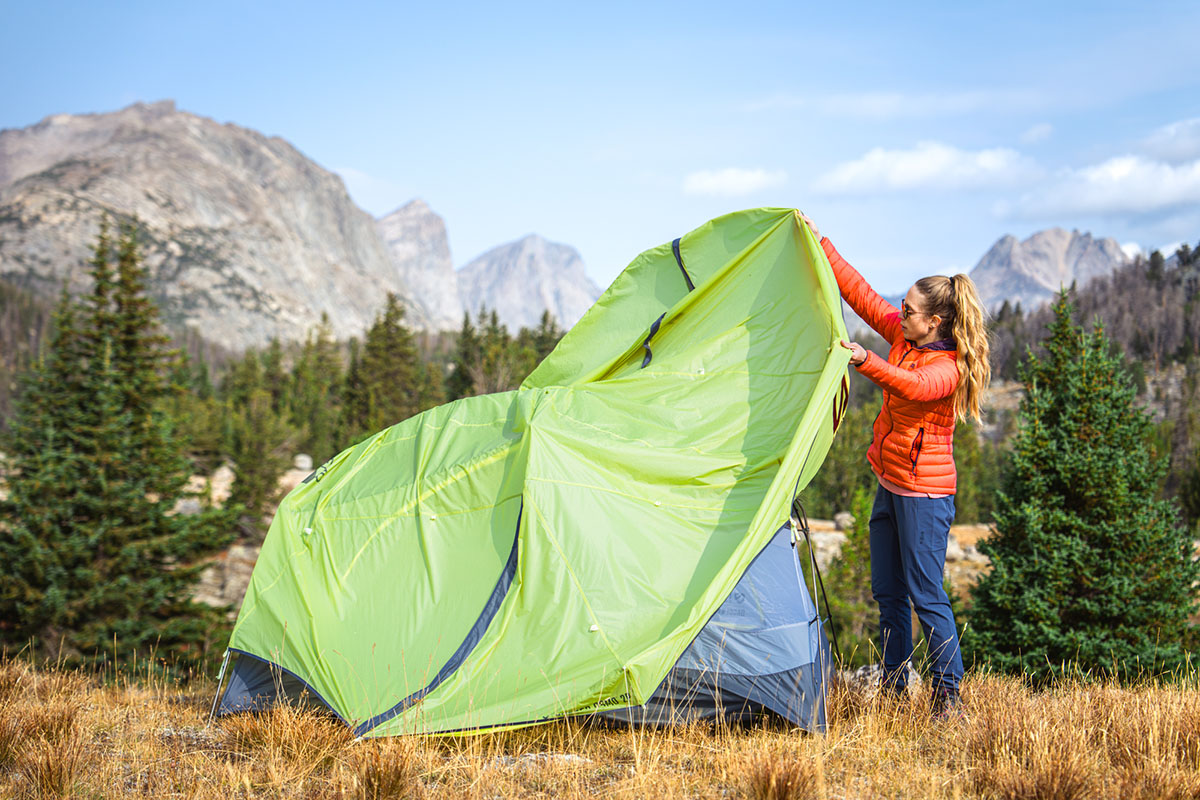
At 20 by 6.5 inches, the Dagger Osmo's packed size lands a little above average for the price and features. On our trip to Wyoming’s Wind River Range, the Dagger was bulkier than the other two-person tents we had with us—Nemo’s own Dragonfly Osmo 2P (19.5 x 5.5 in.) and Big Agnes’ Tiger Wall UL2 (18 x 5 in.)—but we had no issues fitting it in a backpacking pack, even without separating the poles from the main storage sack. Thick fabrics and bulky hub systems can increase packed size, but Nemo has done a pretty good job keeping things light and compact. If you do remove the tent poles, the Dagger’s roll-top stuff sack can be compressed to two-thirds its normal length and secured via a buckle closure.
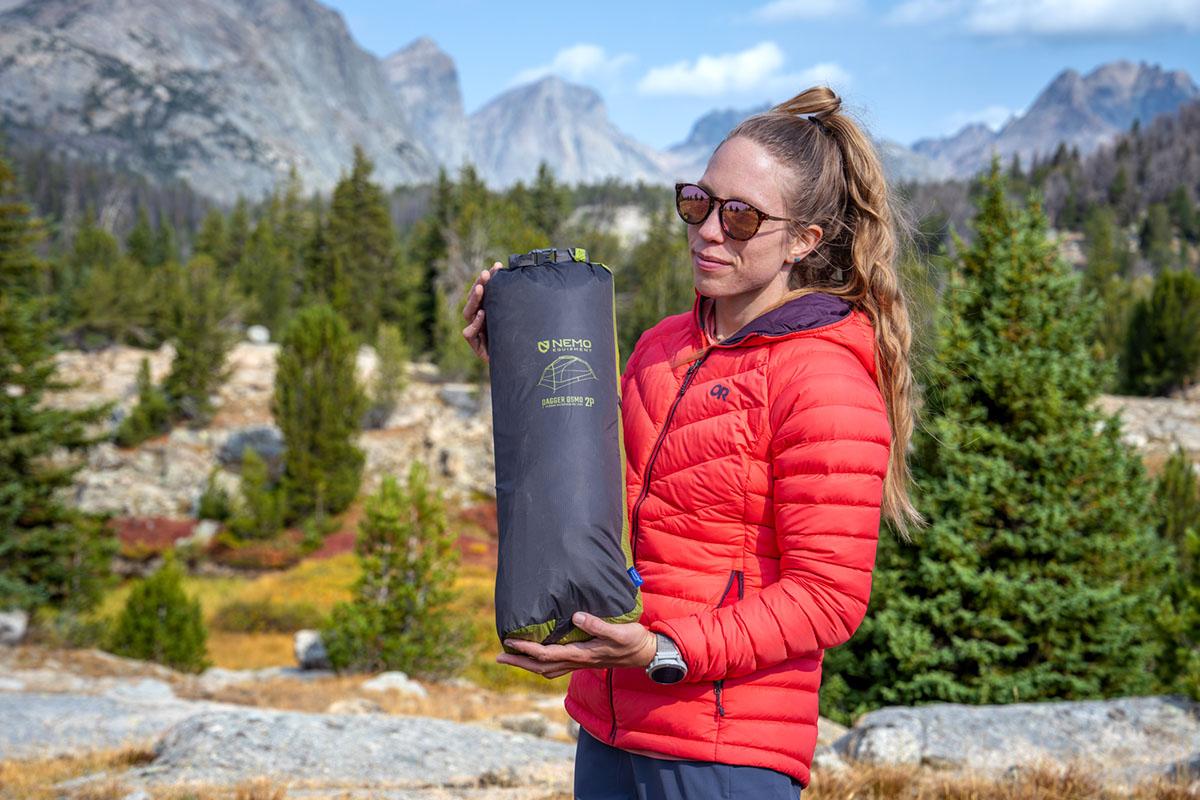
While the latest Dagger Osmo 2P technically has less floor area than the prior version (by 0.7 sq. ft.), the updated pole structure results in a similarly spacious—if not even roomier—feel. All too often, one or both of our sleeping pads make their way up the sidewalls of a so-called two-person model, but not here. Two regular-width sleeping pads fit side-by-side with room to spare, the symmetrical floor is expansive enough to accommodate a long sleeping bag, and the sidewalls are stretched to be nearly vertical. Additionally, the door on the latest version is 4 inches taller than the prior model, which was noticeable in testing, and peak height also went up slightly (from 42 to 43 in.). While the walls do slope downward from the center, the dual hubs and bent poles at each end of the tent create an openness that makes it easy to sit upright almost anywhere without hitting the ceiling. The net result is a truly comfortable place for two backpackers to sleep at night.

For comparison, we’ve also tested Nemo’s ultralight Hornet and Dragonfly, which weigh considerably less but have heavily tapered designs. The walls of those tents have more of an inward slope, and both the Hornet and Dragonfly can just barely fit two regular-width pads side-by-side. This type of design is fine for solo use or for two people in a pinch who really want some of the lightest setups available—and don’t mind being in close quarters—but they’re almost bivy sack-like in nature. In most circumstances, we prefer the Dagger Osmo.
In addition to interior space, durability is often compromised as tent manufacturers look to trim ounces. Thankfully, Nemo didn’t go overboard with the Dagger Osmo, hitting a nice mix of moderately thin fabrics that are pretty resistant to tears and abrasion. The namesake Osmo fabric is comprised of a polyester-nylon ripstop material that’s intended to boost water resistance, stretch less when wet, and eliminate the use of harmful chemicals and perfluorocarbons. It’s difficult to assign an accurate denier (D) rating since the fabric uses two types of yarns, but I’d estimate it’s comparable to tents with 20D to 30D floors and 15D to 20D canopies and rainflies. For comparison, the latest MSR Hubba Hubba LT has a 20D floor, while the Big Agnes Copper Spur UL’s is 15D x 20D.
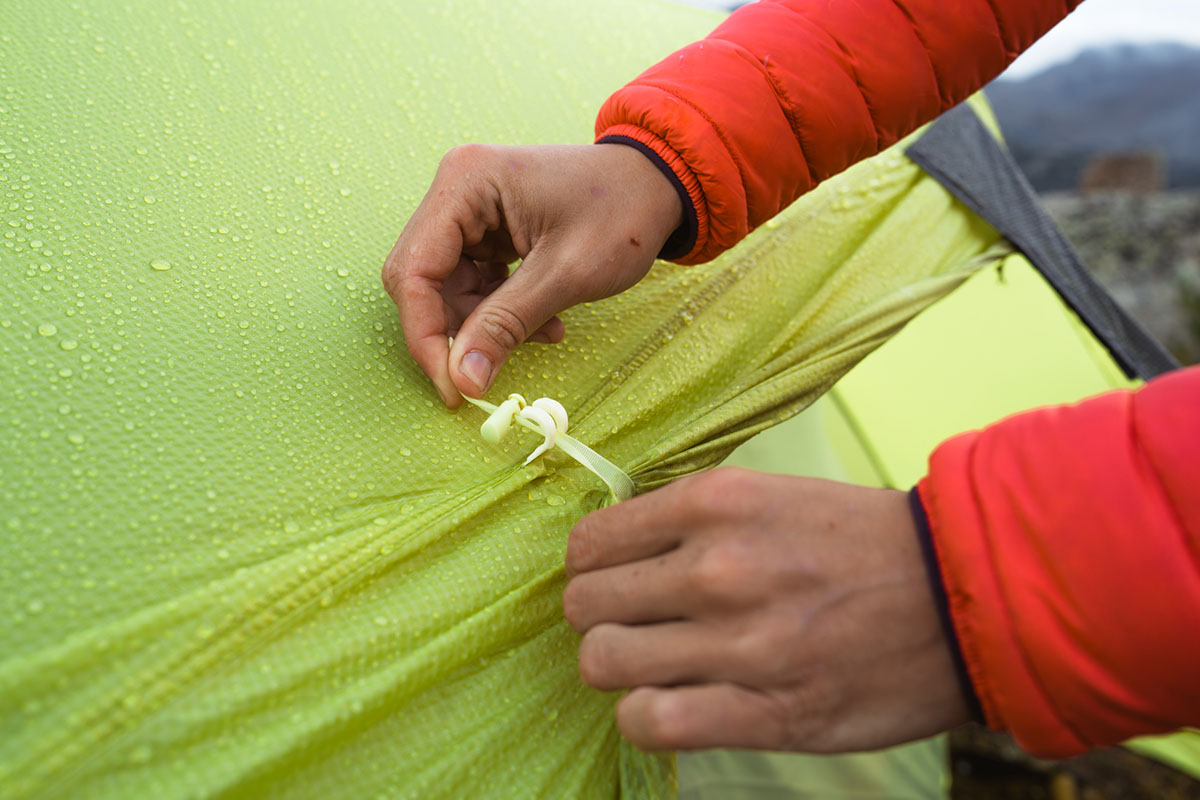
For reference, my tent is holding up mostly well after a backpacking trip to the Wind River Range and a couple follow-up overnights in the Sierras. The only noteworthy issue I’ve encountered thus far is a torn cord at the base of one door (used to stake it out), which snapped during moderate winds. I do feel the fabrics and components Nemo used this time around are a little thinner than prior versions, but it’s not a huge difference, and the tent still has a very high-quality feel. If you’re worried about longevity, one way to maximize the tent’s lifespan is by adding a footprint—Nemo sells one for $70, or you can DIY with Polycryo or Tyvek.
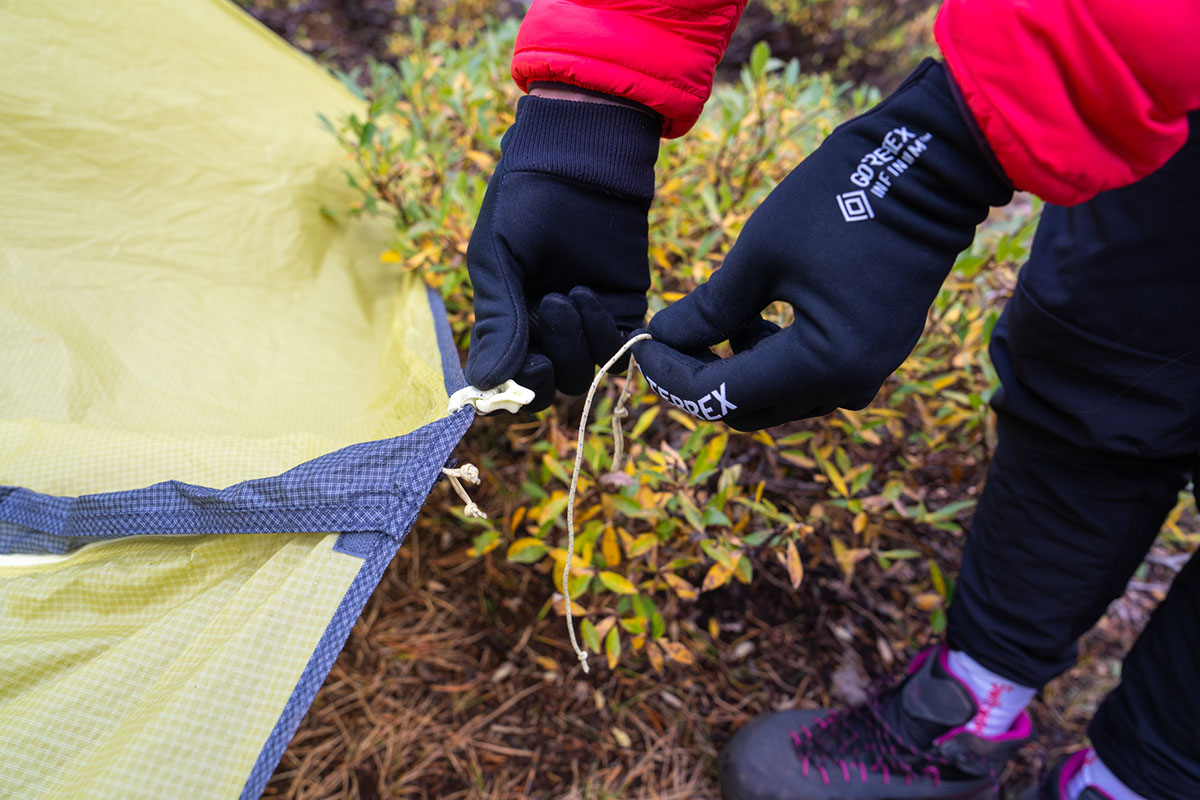
The Nemo Dagger Osmo’s sturdy structure, water-repellent materials, and tall bathtub floor add up to a formidable 3-season tent. As I touched on above, the Osmo fabric is designed to be inherently resistant to moisture and stretching when wet, and it’s done just that. Two areas I was worried about were the raised ends of the rainfly, which arc upwards between the corners and leave a section of single-wall fabric to fend off driving rain. But these concerns were mostly unfounded: The single-wall panels truly are waterproof, and I have yet to experience any leaking. Even in sustained rain while backpacking in Wyoming, the interior remained dry and moisture-free. And a final note: Nemo includes a Landing Zone with the tent, which is a waterproof "tub" that clips into the tent and vestibule to protect your gear from the ground and the elements. I didn’t end up needing to use this feature, but it’s certainly nice to have on truly inclement days.
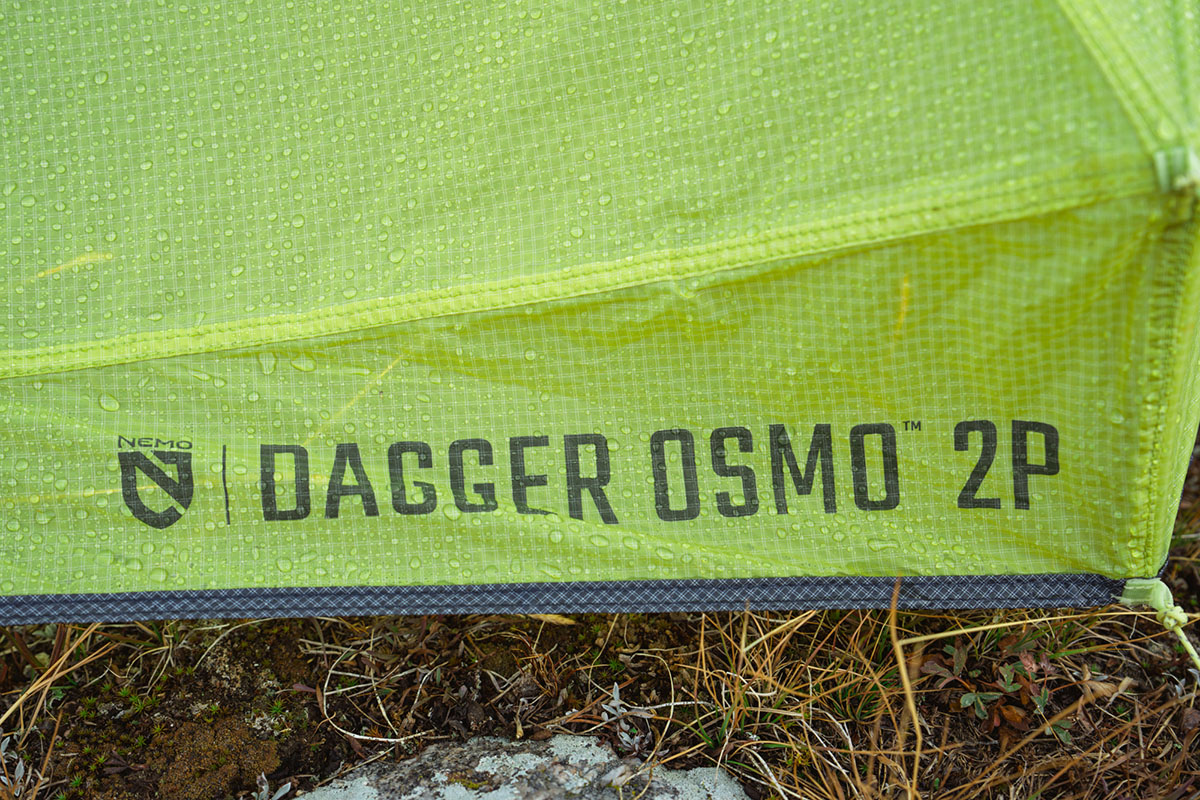
Wind resistance is another clear highlight of the design. We faced decently strong winds during an all-night thunderstorm in the Wind River Range, and the Dagger Osmo 2P remained upright with no threat of collapsing. The poles worked exactly as intended, flexing and bowing to combat the gusts without coming loose or snapping under pressure. As I mentioned above, one of the attachment cords did snap sometime during the night, but it was a quick and easy fix the following morning. It’s also worth noting that the Dagger handily withstood an unexpected hailstorm—while noisy, the rainfly shrugged off the onslaught, leaving me perfectly dry and cozy inside as I waited out the weather.
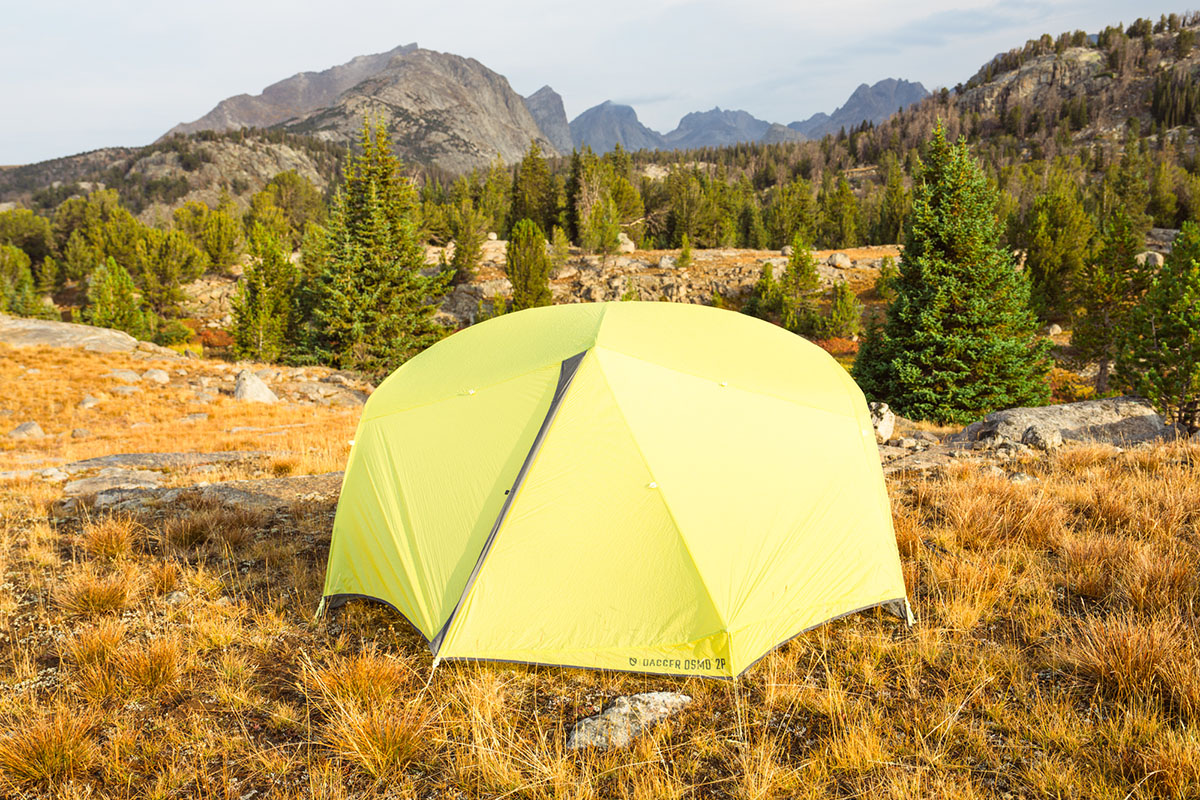
The Dagger Osmo's double-wall build and generous amount of mesh make it reasonably comfortable even on warm summer nights. That being said, the rainfly ventilation system isn’t our favorite and did result in some slight clamminess in damp and humid conditions. Unlike typical backpacking tent designs that have a deployable vent at the roof or sides, the Dagger has vents at the very top of the zippered portion of each vestibule door. The upside is that you can manage the system without leaving the tent, but by deploying the vent, you trim away the upper few inches of the door, making it a little more difficult to get in and out. All things considered, it’s a small nitpick—and the system is completely functional—but the design does fall a little short in this regard.
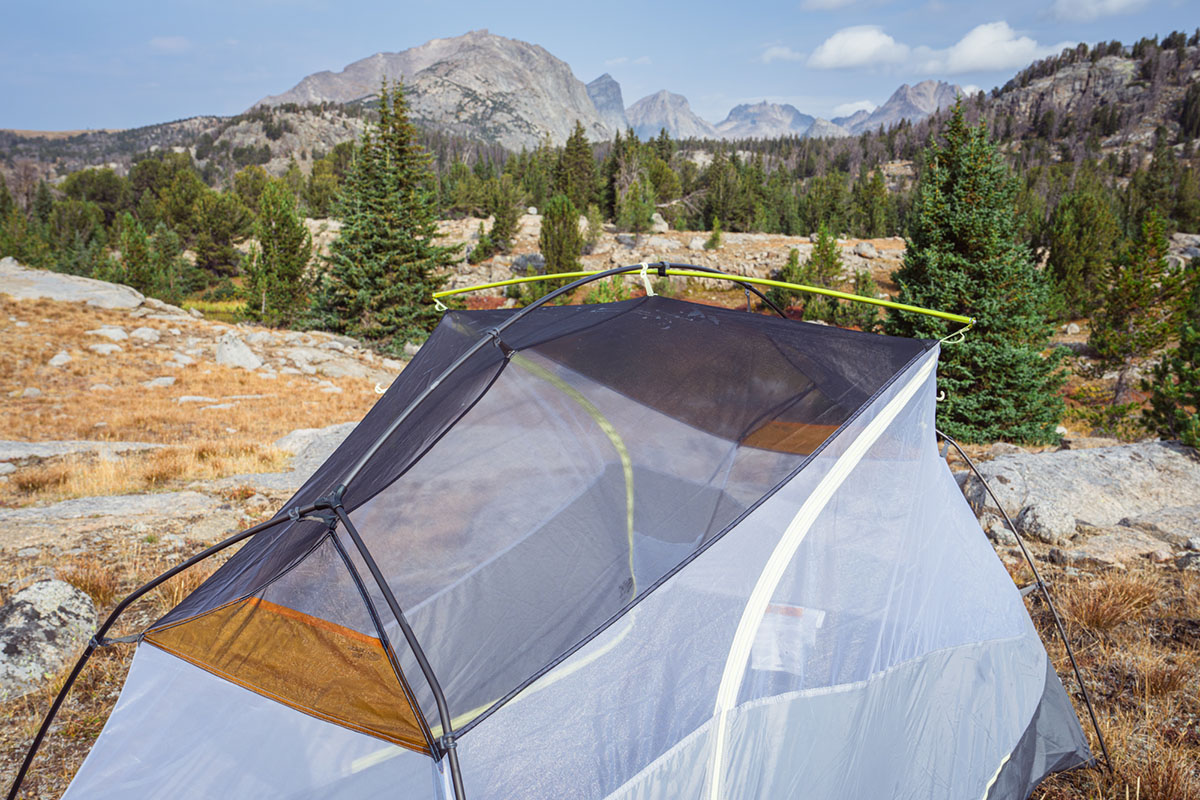
As with Nemo’s Hornet and Dragonfly, the Dagger Osmo has two doors and two vestibules, which is far more convenient than a single door and vestibule—no crawling over your tent mate in the middle of the night to go the bathroom. But unlike the ultralight Hornet, the Dagger’s trapezoidal vestibules are massive. You can easily lay a backpacking pack inside the fully protected space without it leaning up against the rainfly or tent body. The 24.2-square-foot space—a significant 1.4 square feet larger than the prior version thanks to the “Volumizing Stash” strut—hardily beats the MSR Hubba Hubba LT 2 (16 sq. ft.), Big Agnes Copper Spur UL2 (18 sq. ft.), and most other direct competitors. Interior storage is also decent, including two large mesh pockets (one at the head end and one at the feet) and two Nightlight Pockets that can be used for storage or diffused illumination from your headlamp. Some may find themselves wishing for a pocket directly overhead, especially if you’ll be camping with a partner, but it’s not a huge omission, in my opinion.

The Dagger Osmo's fully freestanding build and symmetrical shape is a cinch to set up. It’s just a matter of staking out the corners, attaching the hubbed poles to create the structure (and matching the color-coded poles to the webbing of the same color), and connecting the rainfly. From start to finish, it’s a few short minutes for one person to accomplish, which is comparable to most mainstream backpacking tent models. The freestanding design also makes it really easy to get a taut pitch even on a granite slab—significantly easier than a tent like the semi-freestanding Big Agnes Tiger Wall. Taking down the Dagger is a matter of reversing the process and is just as simple. My only complaint is that the tent doesn’t come with enough stakes to fully guy it out in strong winds, but that’s not a Nemo-specific issue, and it’s always a good idea to bring along extras in case you lose or break any mid-trip.
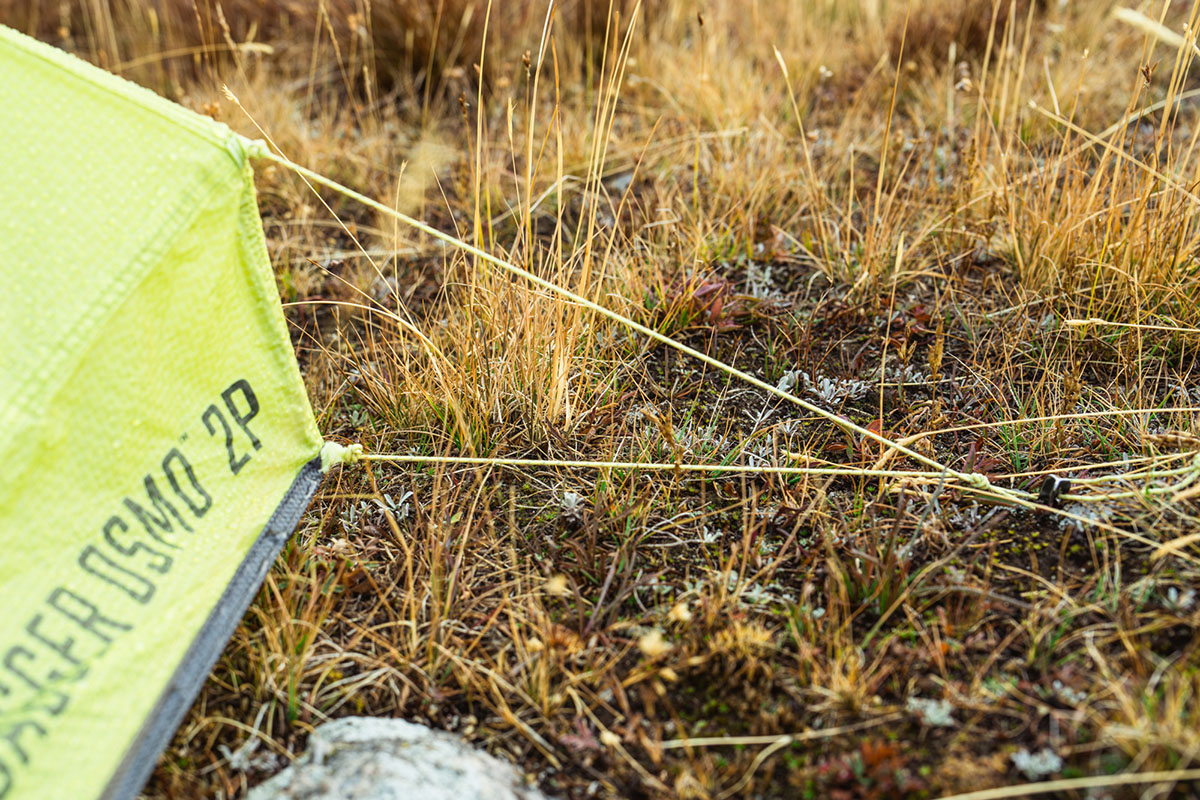
Nemo has positioned themselves as one of the most sustainably minded tent brands in the industry, and the Dagger Osmo is a prime example. Specifically, the Osmo fabric is woven from 100%-recycled yarns that are PFAS-free, which means they forgo the use of harmful “forever chemicals” found in traditional water-repellent coatings. The Osmo material is also solution-dyed, which requires less energy and water use during production compared to standard dyeing practices. Finally, the tent is dubbed a bluesign product—an industry first that indicates it meets strict safety and environmental standards and was produced with minimal impact. Taken together, we commend Nemo for the sustainability effort and applaud them for integrating more environmentally friendly materials into the collection.
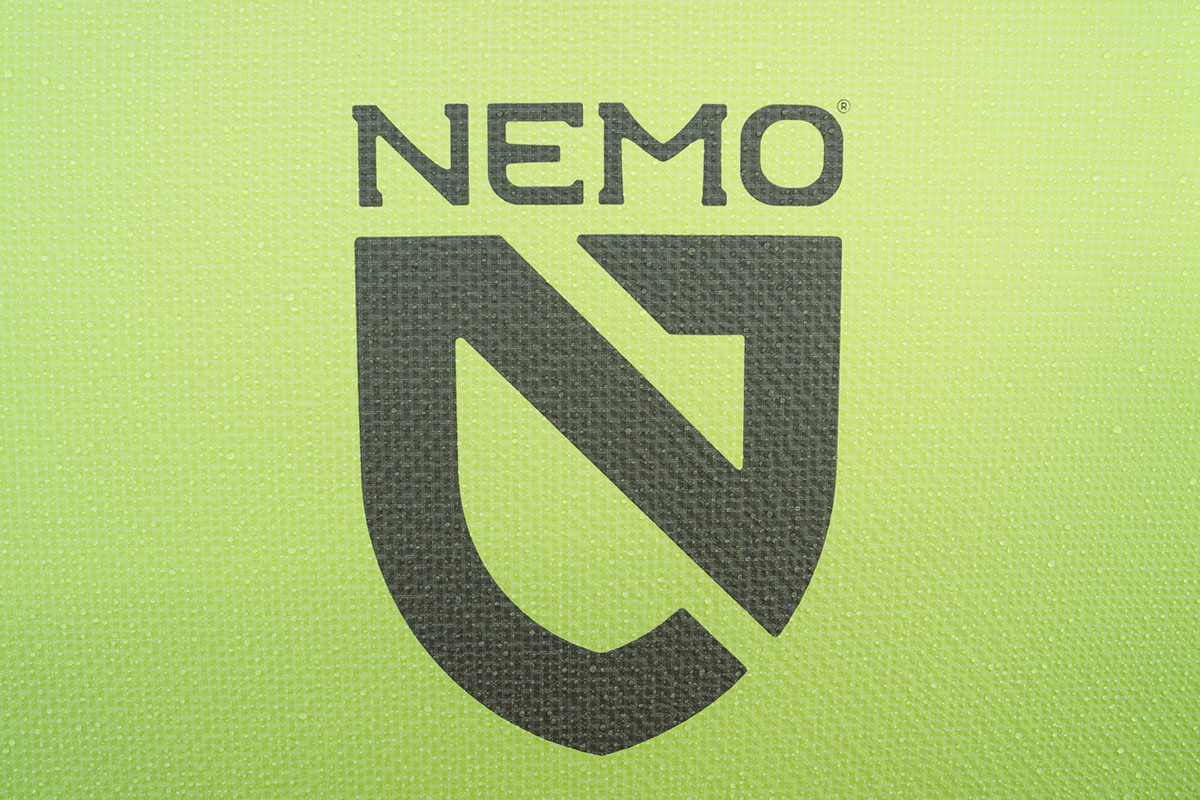
For this review, we tested the two-person Dagger Osmo, and Nemo also offers a three-person model. The design remains largely the same, although the floor expands 20 inches to fit another pad, and weight and price go up by 8 ounces and $80, respectively. In some cases, we recommend sizing up to make the interior more livable—such as purchasing the Nemo Hornet 2P for one backpacker—but the Dagger’s accommodating shape means that we’d only select the 3P if we were planning to add a third person. As we’ve found, the 2P is completely fine for two adults and a medium-sized dog.
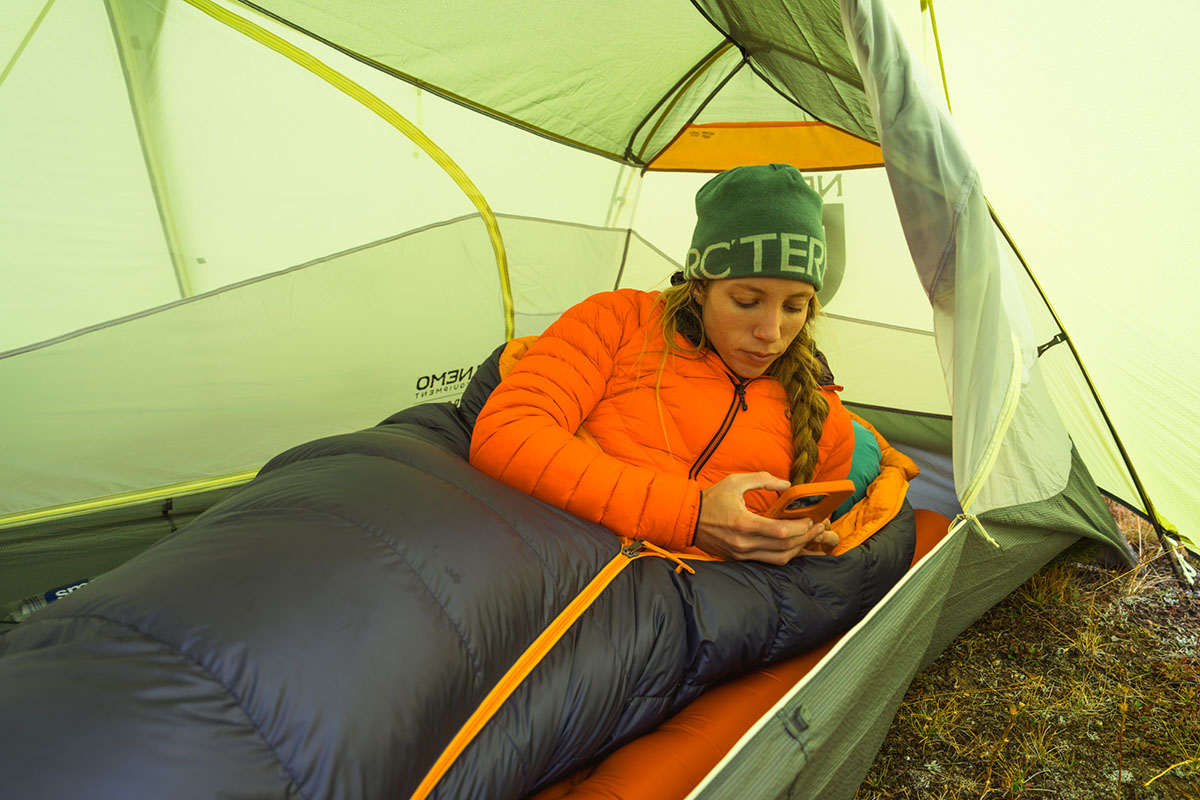
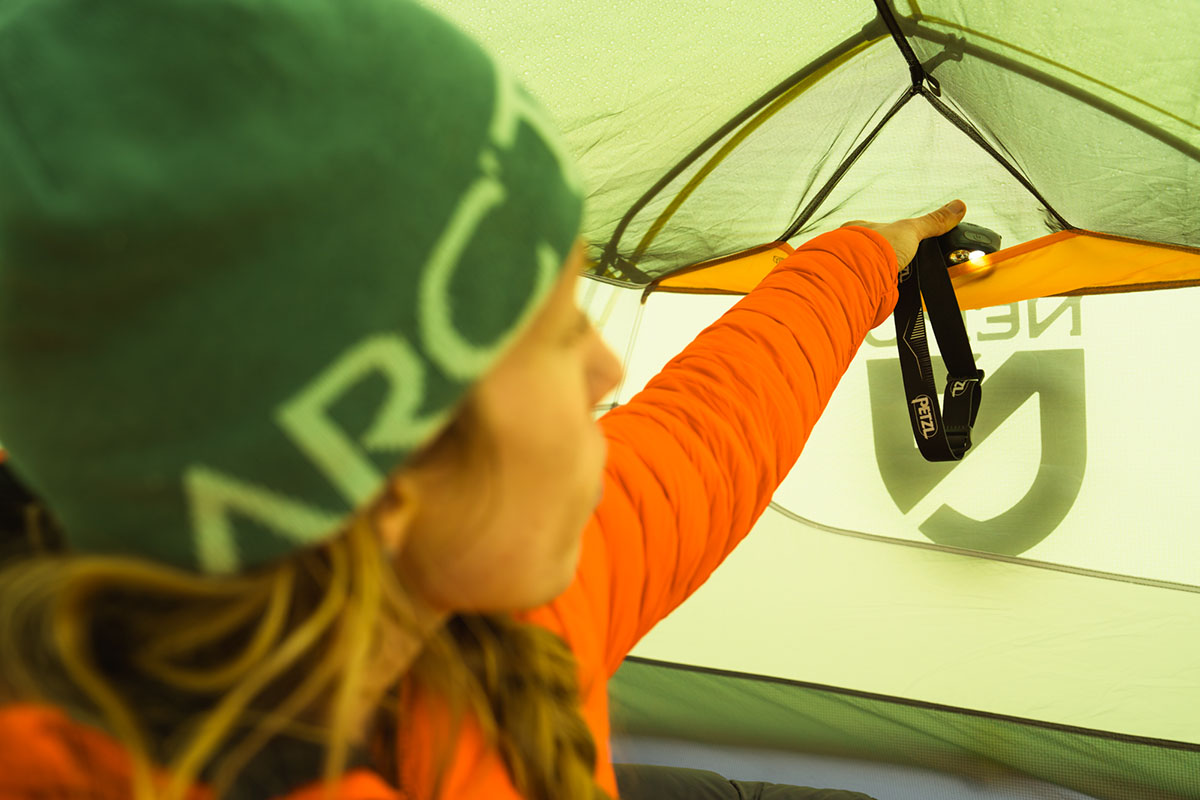
| Tent | Price | Weight | Floor | Area | Height | Door(s) | Capacities |
|---|---|---|---|---|---|---|---|
| Nemo Dagger Osmo 2P | $500 | 3 lb. 15.0 oz. | Unavail. | 30.6 sq. ft. | 43 in. | 2 | 2P, 3P |
| MSR Hubba Hubba LT 2 | $550 | 3 lb. 6.0 oz. | 20D | 32.0 sq. ft. | 40 in. | 2 | 1P, 2P, 3P |
| Nemo Dragonfly Osmo 2P | $480 | 3 lb. 2.0 oz. | Unavail. | 29.0 sq. ft. | 41 in. | 2 | 1P, 2P, 3P |
| Nemo Hornet Osmo 2P | $430 | 2 lb. 8.0 oz. | Unavail. | 27.7 sq. ft. | 39 in. | 2 | 1P, 2P, 3P |
| Big Agnes Copper Spur UL2 | $550 | 3 lb. 0 oz. | 15x20D | 29.0 sq. ft. | 40 in. | 2 | 1P, 2P, 3P, 4P |
The Nemo Dagger Osmo's premium construction and $500 price tag pit it against some of the best sellers in the backpacking tent market. Another one of our favorites that’s also been recently updated is MSR’s Hubba Hubba, which is now called the Hubba Hubba LT. The MSR shares a similar blueprint as the Dagger: lightweight but reasonably tough fabrics, a high level of comfort, and a user-friendly, freestanding design. In parsing out the differences, the MSR features a slightly larger floor area (32 sq. ft.) and a lower weight (3 lb. 6 oz. all in), along with a less intrusive venting system built into the rainfly, although it’s shorter at its peak (40 in.) and has smaller vestibules (8 sq. ft. each). In the end, they’re both great all-around tents, and a final decision will likely come down to preferences on livability and storage (the Dagger wins out) versus weight and ventilation (the MSR gets the edge).
Another Nemo design to consider is their Dragonfly Osmo 2P. One of the biggest benefits is weight: At 3 pounds 2 ounces all in (13 oz. lighter than the Dagger Osmo), the Dragonfly manages to retain good overall livability with two doors and vestibules, 29 square feet of floor area, and a generous 41-inch peak height. However, the Dragonfly tapers at the feet (compared to the Dagger’s symmetrical layout) and is noticeably more cramped for two backpackers. In testing, we also found its pole structure was more prone to flexing and bowing in strong winds, and the materials aren’t as durable or confidence-inspiring (for more, see our in-depth Dragonfly review). Unless weight is your primary consideration, we consider the $20-pricier Dagger Osmo to be the more complete and well-rounded option for most.
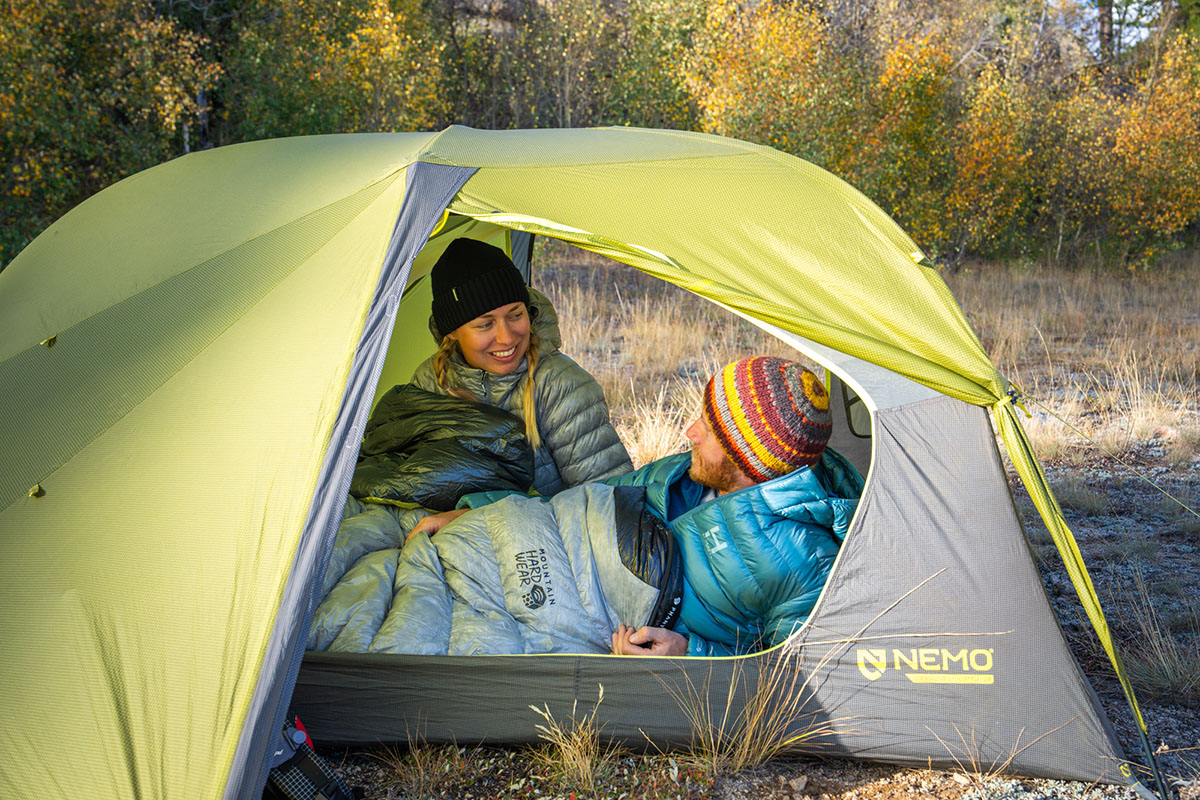
As we touched on above, Nemo’s own Hornet Osmo is an even lighter option to consider at 2 pounds 8 ounces all in. However, you can expect a number of concessions, the biggest of which is livability: The Hornet features a 27.7-square-foot-interior that tapers at the foot end, from 51 inches to just 43 inches, making it a tight squeeze. There’s also less headroom (peak height is 39 in.), and the vestibules are smaller at 7.1 square feet each. Finally, the Hornet is a semi-freestanding design that requires more thought and effort to set up, and the pole layout isn’t as confidence-inspiring in strong winds. The two-person model will save you a considerable $70 compared to the Dagger, but we consider the Dagger to be the better buy for recreational backpackers who care more about livability and comfort than minimizing weight and bulk.
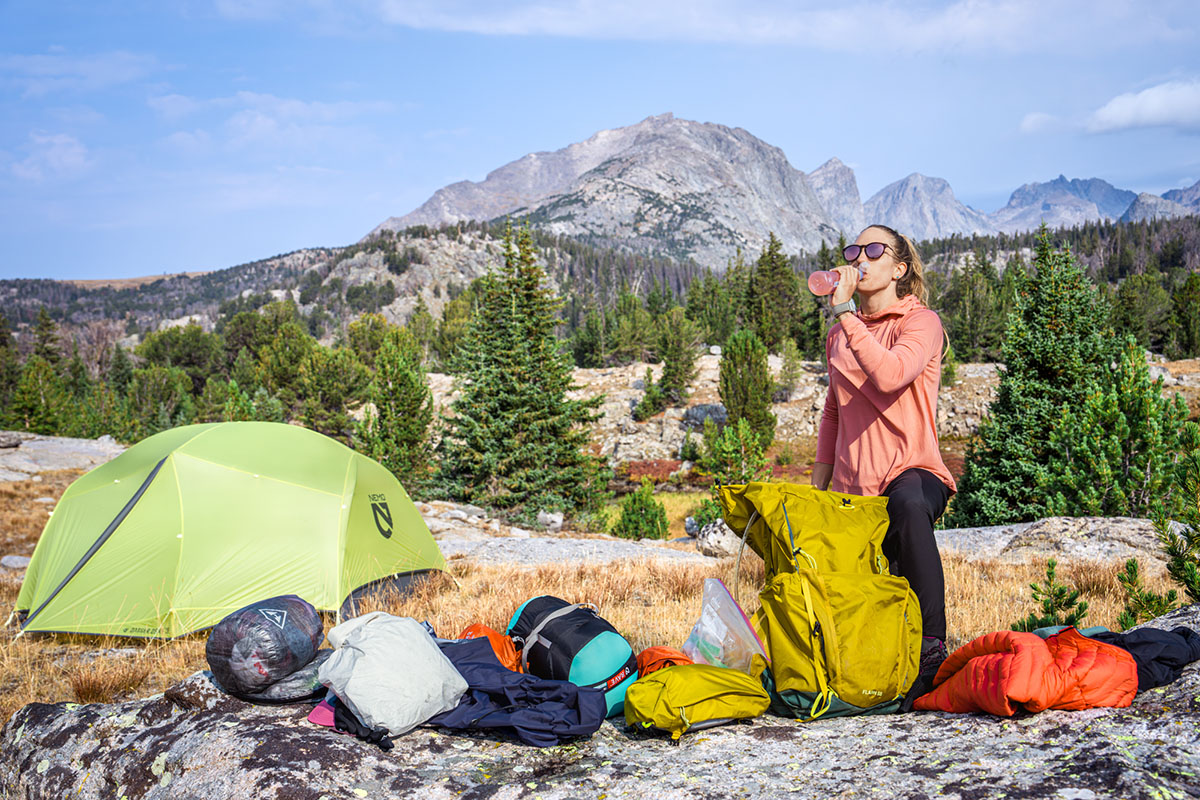
A final challenger to the Dagger is the Big Agnes Copper Spur UL2, which has been at or near the top of our tent rankings for years. Big Agnes recently gave the design a revamp, ditching the “HV” (short for high-volume) designation but retaining most of what we love about the popular tent. Highlights include a very competitive 3-pound weight, quality DAC Featherlight poles, two doors and vestibules, and a respectable 29-square-foot interior that’s well suited for two backpackers. The Nemo offers better overall interior space and vestibule square footage for $50 less, but we’re big fans of the Copper Spur’s combination of weight, livability, and build quality. The Copper Spur is also offered in XL variations, with the UL2 XL model checking in at 3 pounds 5 ounces all in with an even larger 36-square-foot interior. Price goes up to $580, but those looking to maximize comfort for the weight may want to consider spending up.
Back to the Nemo Dagger 2P Review See Our Backpacking Tents Guide